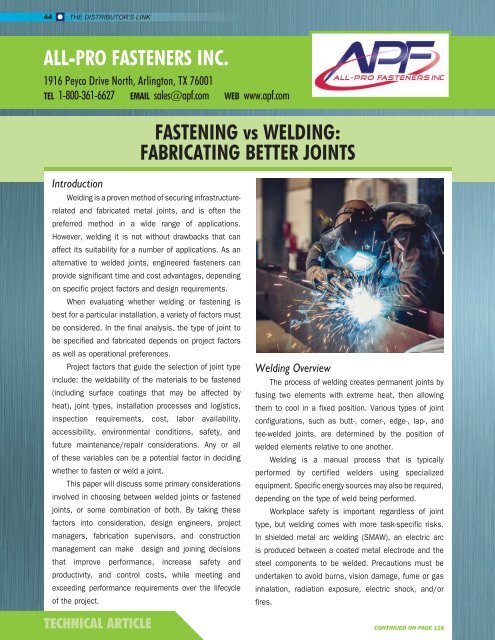FALL 2021
Distributor's Link Magazine Fall 2021 / Vol 44 No 4
Distributor's Link Magazine Fall 2021 / Vol 44 No 4
You also want an ePaper? Increase the reach of your titles
YUMPU automatically turns print PDFs into web optimized ePapers that Google loves.
44<br />
THE DISTRIBUTOR’S LINK<br />
ALL-PRO FASTENERS INC.<br />
1916 Peyco Drive North, Arlington, TX 76001<br />
TEL 1-800-361-6627 EMAIL sales@apf.com WEB www.apf.com<br />
FASTENING vs WELDING:<br />
FABRICATING BETTER JOINTS<br />
Introduction<br />
Welding is a proven method of securing infrastructurerelated<br />
and fabricated metal joints, and is often the<br />
preferred method in a wide range of applications.<br />
However, welding it is not without drawbacks that can<br />
affect its suitability for a number of applications. As an<br />
alternative to welded joints, engineered fasteners can<br />
provide significant time and cost advantages, depending<br />
on specific project factors and design requirements.<br />
When evaluating whether welding or fastening is<br />
best for a particular installation, a variety of factors must<br />
be considered. In the final analysis, the type of joint to<br />
be specified and fabricated depends on project factors<br />
as well as operational preferences.<br />
Project factors that guide the selection of joint type<br />
include: the weldability of the materials to be fastened<br />
(including surface coatings that may be affected by<br />
heat), joint types, installation processes and logistics,<br />
inspection requirements, cost, labor availability,<br />
accessibility, environmental conditions, safety, and<br />
future maintenance/repair considerations. Any or all<br />
of these variables can be a potential factor in deciding<br />
whether to fasten or weld a joint.<br />
This paper will discuss some primary considerations<br />
involved in choosing between welded joints or fastened<br />
joints, or some combination of both. By taking these<br />
factors into consideration, design engineers, project<br />
managers, fabrication supervisors, and construction<br />
management can make design and joining decisions<br />
that improve performance, increase safety and<br />
productivity, and control costs, while meeting and<br />
exceeding performance requirements over the lifecycle<br />
of the project.<br />
Welding Overview<br />
The process of welding creates permanent joints by<br />
fusing two elements with extreme heat, then allowing<br />
them to cool in a fixed position. Various types of joint<br />
configurations, such as butt-, corner-, edge-, lap-, and<br />
tee-welded joints, are determined by the position of<br />
welded elements relative to one another.<br />
Welding is a manual process that is typically<br />
performed by certified welders using specialized<br />
equipment. Specific energy sources may also be required,<br />
depending on the type of weld being performed.<br />
Workplace safety is important regardless of joint<br />
type, but welding comes with more task-specific risks.<br />
In shielded metal arc welding (SMAW), an electric arc<br />
is produced between a coated metal electrode and the<br />
steel components to be welded. Precautions must be<br />
undertaken to avoid burns, vision damage, fume or gas<br />
inhalation, radiation exposure, electric shock, and/or<br />
fires.<br />
TECHNICAL ARTICLE CONTINUED ON PAGE 124
















